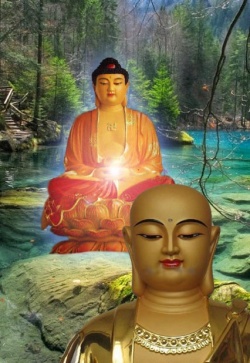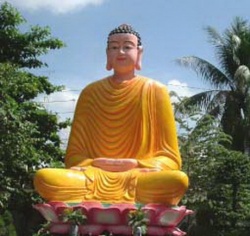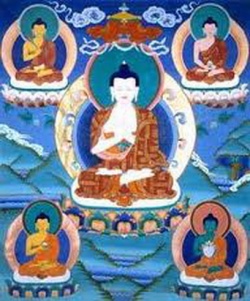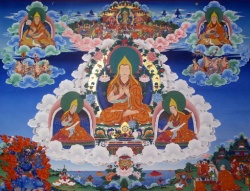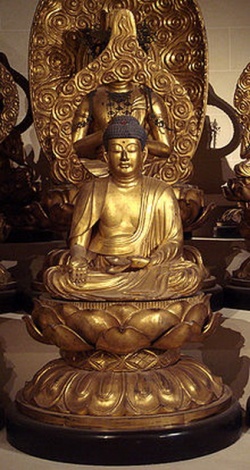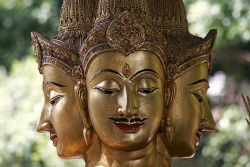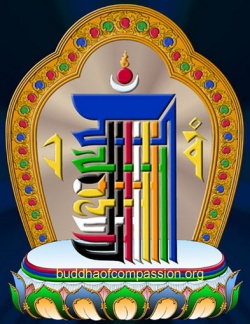Difference between revisions of "Vaipulya"
(Created page with "thumb|250px| vaipulya; The Sanskrit tradition places vaipulya,as a number of important Mahāyāna works, including the Lotus Sūtra,...") |
m (Text replacement - "Texts" to "Texts") |
||
| (15 intermediate revisions by 3 users not shown) | |||
| Line 1: | Line 1: | ||
| − | [[File:Im45.jpg|thumb|250px|]] | + | [[File:Im45.jpg|thumb|250px|]]<nomobile>{{DisplayImages|2003|4178|3972|4073|644|1496}}</nomobile> |
| − | [[vaipulya]]; The [[Sanskrit]] [[tradition]] places [[vaipulya]],as a number of important [[Mahāyāna]] works, including the [[Lotus Sūtra]], [[Aṣṭasāhasrikā-prajñāpāramitā]], and [[Laṅkāvatāra-sūtra]]. | + | |
| − | {{ | + | |
| − | [[Category: | + | |
| + | |||
| + | |||
| + | <poem> | ||
| + | [[vaipulya]]; The [[Sanskrit]] [[tradition]] places [[vaipulya]],as a number of important [[Mahāyāna]] works, [[including]] the [[Lotus Sūtra]], [[Aṣṭasāhasrikā-prajñāpāramitā]], and [[Laṅkāvatāra-sūtra]] and so on. | ||
| + | |||
| + | |||
| + | |||
| + | ==Great [[Mahayana Sutras]]== | ||
| + | |||
| + | |||
| + | |||
| + | Introduction | ||
| + | |||
| + | There are in [[existence]] quite a number of [[Mahayana sutras]], some of them [[existing]] in the original [[Sanskrit]], others [[existing]] in both the original [[Sanskrit]] and in {{Wiki|Chinese}}, [[Tibetan]] translations; some [[existing]] only in translation, but altogether there are several hundreds of these [[Mahayana sutras]]. | ||
| + | |||
| + | And there are various kinds of [[Mahayana sutras]]. | ||
| + | |||
| + | Some of the more important - if you like, some of the most important - of the [[Mahayana sutras]] are known as [[vaipulya sutras]], | ||
| + | |||
| + | and [[vaipulya]] means broad, vast, extensive; and some of these [[Mahayana sutras]] are so called, are called [[vaipulya sutras]], | ||
| + | |||
| + | not just because they are very lengthy - though some of them are very lengthy indeed; some of them amount practically to a whole thick volume, at least in the English translation. | ||
| + | |||
| + | They are so called because they are broad and vast and extensive in scope, that is to say with [[respect]] to their [[subject]] {{Wiki|matter}}; with [[respect]] to the topics with which they deal. | ||
| + | |||
| + | And [[essentially]], basically, the [[subject]] {{Wiki|matter}} of each of these [[vaipulya sutras]], these broad, vast, extensive [[sutras]], is the total [[Dharma]]: that is to say, not just one particular subdivision of the [[teaching]], not just one particular section, not even just one particular aspect, | ||
| + | |||
| + | but the total [[Dharma]], though each of the [[vaipulya sutras]] sees that total all-inclusive [[Dharma]] from its [[own]] special, its [[own]] {{Wiki|distinctive}}, angle of [[vision]]; and perhaps also sees it in terms of the special needs, the special [[spiritual]] needs, of a particular class of followers.1 | ||
| + | |||
| + | [[File:145x.jpg|thumb|250px|]] | ||
| + | Each of the [[vaipulya sutras]] is, therefore, complete in itself. | ||
| + | |||
| + | It can be studied, it can be reflected on, even practised, without reference to any other [[sutra]], without reference to any other formulation of the [[Dharma]], at least so far as the [[spiritual]] needs of the [[student]] are concerned. | ||
| + | |||
| + | If you want to study the [[sutra]] from a {{Wiki|linguistic}} point of [[view]] or {{Wiki|scholastic}} point of [[view]], that's another {{Wiki|matter}}, | ||
| + | |||
| + | but from the [[spiritual]] point of [[view]] one can confine oneself quite sufficiently, quite satisfactorily, to just that one [[vaipulya]] [[sutra]]. | ||
| + | |||
| + | |||
| + | There are many sets of lists of [[Mahayana Vaipulya Sutras]]. P.V. Bapat in his [[book]], 2500 Years Of [[Buddhism]], CHAPTER VII, on [[BUDDHIST]] LITERATURE, lists | ||
| + | |||
| + | the [[Astasahasrika-prajnaparamita]], | ||
| + | the [[Saddharma-pundarika]], | ||
| + | the [[Lalitavistara]], | ||
| + | the [[Lankavatara]], | ||
| + | the [[Suvarna-prabhasa]], | ||
| + | the [[Gandavyuha]], | ||
| + | the [[Tathagata-guhyaka]], | ||
| + | the [[Samadhi]]-[[raja]] and | ||
| + | the [[Dasabhumisvara]] as | ||
| + | |||
| + | |||
| + | |||
| + | ==The nine [[Vaipulya Sutras]]== | ||
| + | |||
| + | |||
| + | Here I accept these eight as the list of [[Vaipulya Sutras]] or Great [[Mahayana Sutras]], combinding the [[Gandavyuha]] and the [[Dasabhumisvara]] under [[Avatamsaka]], and will identify the others that are sometimes also listed as [[Vaipulya Sutras]]. | ||
| + | |||
| + | |||
| + | These eight are the: | ||
| + | |||
| + | |||
| + | [[Prajnaparimita]] texts or [[Perfection of Wisdom]]. | ||
| + | [[Lalitavistara]], or [[Detailed Naration on the Spirit of the Buddha]]. | ||
| + | [[Saddharmapundarīka]], or [[Lotus Sutra]]. | ||
| + | [[Suvarnaprabhasa]], or [[Rays of Gold]]. | ||
| + | [[Avatamsaka]], or [[Flower Garland Sutra]] | ||
| + | [[Tathāgatagarbha doctrine]], or [[Teachings on Buddha Nature]]. | ||
| + | [[Samadhiraja]], or [[King of Concentration]]. | ||
| + | [[Lankavattara]], or [[Entering into Sri Lanka]]. | ||
| + | |||
| + | |||
| + | 1. [[Prajnāpāramitā]] ([[般若波罗蜜多]]) Texts, the "[[Perfection of Wisdom]]" | ||
| + | [[File:Images047.jpg|thumb|250px|]] | ||
| + | The [[Prajñāpāramitā Sutras]] are a genre of [[Mahayana]] [[Buddhist scriptures]] dealing with the aspects of a [[bodhisattva]]'s cultivations called the [[paramitas]] on the [[subject]] of the [[Perfection]] of [[Wisdom]]. | ||
| + | |||
| + | The term [[Prajñāpāramitā]] alone never refers to a specific text, but always to the class of {{Wiki|literature}}. Some [[scholars]] think it is from derived from the teachings of the [[Mahāsāmgikas]]. | ||
| + | |||
| + | These [[Prajñāpāramitā Sutras]] can be broadly placed into aix groups, namely: | ||
| + | |||
| + | The [[Astasāhas-rikā-prajnāpāramitā-sūtra]] or the "[[Perfection of Wisdom in 8,000 Lines]]" is dated at ca. 100 BCE to 100 CE making it the oldest [[sūtra]] among the [[prajnāpāramitā]] {{Wiki|literature}}. 2 | ||
| + | |||
| + | Another text, which is [[Lokaksema]]’s ([[支婁迦讖]] [[Zhī Lóujiāchèn]]) {{Wiki|Chinese}} translation of the “[[道行般若經]] [[Dao Xing Bo Re Jing]]” or “The [[Sūtra of the Path for Practicing Prajnā]]” from 179 CE, is an early extended version of the [[Astasāhas-rikā-prajnāpāramitā-sūtra]]. 3 | ||
| + | |||
| + | Between the years 100 CE and 300 CE, the [[Astasāhas-rikā-prajnāpāramitā-sūtra]] was expanded into large versions. They are also collectively known as the "[[Larger Perfection of Wisdom Sutras]]". 4 Examples of such [[sutras]] are: | ||
| + | |||
| + | |||
| + | [[Daþa sāhas-rikā-prajnāpāramitā-sūtra]], or the "[[Perfection of Wisdom in 10,000 lines]], | ||
| + | [[Astāsaśa sāhas-rikā-prajnāpāramitā-sūtra]], or the "[[Perfection of Wisdom in 18,000 lines]]. | ||
| + | [[Pañcavimsati sāhas-rikā-prajnāpāramitā-sūtra]], or the "[[Perfection of Wisdom in 25,000 lines]]. | ||
| + | [[Śata sāhas-rikā-prajnāpāramitā-sūtra]], or the "[[Perfection of Wisdom in 100,000 lines]]. | ||
| + | [[File:Jse.jpg|thumb|250px|]] | ||
| + | |||
| + | |||
| + | The [[prajnāpāramitā]] {{Wiki|literature}} were also contracted or abridged. According to {{Wiki|Edward Conze}} in his [[book]] the "[[Perfect Wisdom]]; [[The Short Prajnaparamita Texts]]", [[Buddhist]] Publishing Group, Totnes. (Luzac reprint), ISBN 0-946672-28-8 5, also sited the [[Perfection]] of [[Wisdom]] in: | ||
| + | |||
| + | |||
| + | "[[Perfection of Wisdom in 500 lines]]". | ||
| + | "[[Perfection of Wisdom in 700 lines]]". | ||
| + | |||
| + | Other short [[sutras]] from ca. 300 CE to 500 CE includes the | ||
| + | |||
| + | [[Prajñāpāramitā Hṛdaya Sutra]] also called the [[Heart Sutra]], | ||
| + | [[Prajñāpāramitā Vajracchedikā Sutra]] or the [[Diamond Sutra]]. | ||
| + | [[Abhisamayālaṃkāra]] or the [[Ornament of Clear Realization]] | ||
| + | |||
| + | |||
| + | which is it is a commentary on the hidden meaning of the [[Prajñaparamita Sutras]], describing the entire journey of the [[bodhisattva]], from the generation of [[bodhichitta]] to the [[attainment]] of full [[omniscience]]. 6 | ||
| + | |||
| + | Short [[sutras]] from the period of [[Tantric]] [[influence]] and of [[absorption]] into believe in [[magic]] from ca. 600 CE to 1200 CE. 7 | ||
| + | |||
| + | The collection of [[Prajnaparamita]] [[Sutras]], over 40 in number, originate in [[India]] and were first written in an [[Indic]] or {{Wiki|Central Asia}}n [[language]] other than [[Sanskrit]]. | ||
| + | |||
| + | [[File:22vnshou.jpg|thumb|250px|]] | ||
| + | 2. [[Lalitavistara]], or [[Detailed Naration on the Spirit of the Buddha]]. | ||
| + | |||
| + | The [[Lalitavista]] 8 is a [[Sanskrit]] [[Buddhist text]] of great importance. | ||
| + | |||
| + | Apart from being a {{Wiki|biography}} of [[Buddha]], originally of the early [[Buddhist]] [[Sarvastivada]] School, it throws a considerable [[light]] also on the {{Wiki|social}} and {{Wiki|cultural}} history of [[India]] during the early centuries of the Common {{Wiki|era}}. | ||
| + | |||
| + | This is a compilation of various works by no single author and includes some material from the [[Sarvastivada school]]. | ||
| + | |||
| + | It deals with the [[life]] of the [[Buddha]]. | ||
| + | |||
| + | The [[scholar]], P. L. [[Vaidya]] dates the finished [[Sanskrit]] text to the third century. | ||
| + | |||
| + | There were at least five versions of the [[Lalitavistara]] in [[China]]. | ||
| + | |||
| + | The [[Lalitavistara]] [[forms]] a part of [[Nanadharma]] of {{Wiki|Nepalese}} [[Mahayana Buddhism]] and also of the [[Tibetan canon]] and it was translated into that [[language]] in the 9th century CE. | ||
| + | |||
| + | It may be mentioned here that the [[Tibetan]] translation of the [[Lalitavistara]] is considered to be very [[Wikipedia:Authenticity|authentic]] and close to the [[Sanskrit]] text. | ||
| + | |||
| + | |||
| + | 3. [[Saddharma-pundarīka-sūtra]], or [[Lotus Sutra]]. | ||
| + | |||
| + | |||
| + | Another early [[Mahāyāna]] text, the [[Saddharma-pundarīka sutra]] 9 or the [[Lotus Sutra]], it speaks about the [[arhat]] {{Wiki|ideal}}. | ||
| + | |||
| + | This [[sūtra]] is considered the paradigmatic text on the developed [[Buddhology]] of the [[Mahāyāna]]. | ||
| + | |||
| + | Here the [[Buddha]] is presented as a [[supernatural]] being, [[eternal]], [[unchanging]]; at the same time he is [[Buddha]] by [[virtue]] of the fact that he has become free from all conceptions of being and nonbeing. | ||
| + | |||
| + | It is a major text, of which the [[Tendai]] ([[T'ien T'ai]]) use as a main [[scripture]]. | ||
| + | |||
| + | It teaches the identification of the historical [[Buddha]], with the [[Transcendental]] [[Buddha]]. | ||
| + | |||
| + | |||
| + | |||
| + | 4. [[Suvarnaprabhasa]], or [[Rays of Gold]] ([[金光明經]]; [[jīn guāng míng jīng]]). | ||
| + | |||
| + | The {{Wiki|recitation}} of [[Suvarnaprabhasa-sutra]] 10 and the {{Wiki|ceremonies}} based on it were meant for [[peace]] and [[prosperity]] of the country, | ||
| + | |||
| + | for its [[protection]] from enemies, for the well being of the public and the rulers, and to save the masses from {{Wiki|calamities}} because in the forth [[chapter]] ([[I’tsing]]’s translation) it promises four kinds of [[blessings]] to the countries in which it is read: | ||
| + | |||
| + | The [[kings]] of those countries shall be free of {{Wiki|diseases}} and other {{Wiki|calamities}}, their [[life]] will be long and [[obstacle]] free, they will have no enemies, their [[warriors]] will be brave and strong, and there shall be [[peace]], abundance and [[joy]], and [[saddharma]] will prevail everywhere. | ||
| + | [[File:233 7460.jpg|thumb|250px|]] | ||
| + | |||
| + | |||
| + | 5. [[Avatamsaka Sutra]] ([[華嚴經]]; [[huá yán jīng]]), or The [[Flower Garland Sutra]] | ||
| + | |||
| + | |||
| + | The [[essence]] of the [[Avatamsaka Sutra]] ([[華嚴經]]; [[huá yán jīng]]), or The [[Flower Garland Sutra]], lies in it's [[Chapter]] 26 and the last [[chapter]], [[Chapter]] 40, which are, | ||
| + | |||
| + | [[Dasabumisvara]], [[Dasabhūmikabhāsya]] or [[Lord of the Ten Stages]], ([[十地経]]; [[shí dì jīng]]) | ||
| + | |||
| + | [[Gandavyuha]], or [[The Analysis of the Knots]]. | ||
| + | |||
| + | The [[Dasabumisvara]], [[Dasabhūmikabhāsya]] or [[Lord of the Ten Stages]], is an early, influential [[Mahayana Buddhist scripture]] written by [[Vasubandhu]] in [[Sanskrit]] and translated into {{Wiki|Chinese}} by [[Bodhiruci]] and others, during the 6th Century. | ||
| + | |||
| + | Here the [[Buddha]] describes [[ten stages]] 11 of [[development]] that a [[bodhisattva]] must progress through in [[order]] to accomplish full [[Enlightenment]] and [[Buddhahood]], as well as the [[subject]] of [[Buddha nature]] and the [[awakening]] of the [[aspiration]] for [[Enlightenment]]. | ||
| + | |||
| + | [[The Lord of the Ten Stages]], is also elevated as an {{Wiki|independent}} [[sutra]]. | ||
| + | |||
| + | The same [[teaching]] can again be found in modified [[form]] in the 39th. [[Chapter]] as part of the journey of the [[bodhisattva]] [[Sudhana]]. | ||
| + | |||
| + | There is a translation of the [[Gandavyuha]] 12 by [[Prajñā]] around ca. 798. | ||
| + | |||
| + | The second translation includes more [[sutras]] than the first, and the [[Tibetan]] translation, which is still later, includes even more. [[Scholars]] conclude that [[sutras]] were being added to the collection. | ||
| + | |||
| + | The [[sutra]] has not survived in [[Sanskrit]]. | ||
| + | |||
| + | [[Chapter]] 40 of the [[Avatamsaka Sutra]] ([[華嚴經]]; [[huá yán jīng]]) or the [[Gandavyuha]], or [[The Analysis of the knots]].is also elevated as an {{Wiki|independent}} [[sutra]]. | ||
| + | |||
| + | |||
| + | 6. [[Tathāgatagarbha doctrine]], or [[The Teachings on Buddha Nature]] | ||
| + | |||
| + | |||
| + | In [[Mahayana]] and [[Tantric Buddhism]], the [[Tathāgatagarbha doctrine]], 13 often [[essentially]] the same as the [[Buddha nature]] {{Wiki|concept}}, teaches that each [[sentient being]] contains the intrinsic, effulgent [[Buddhic]] [[element]] or indwelling [[potency]] for becoming a [[Buddha]]. | ||
| + | |||
| + | There are conflicting interpretations of the [[idea]] in [[Mahayana]] [[thought]]. | ||
| + | |||
| + | The [[idea]] may be traced to [[Abhidharmic]] [[thought]], and ultimately to statements of the [[Buddha]] in the [[Nikayas]]. [[Buddha-nature]] and [[sugatagarbha]] are synonyms for [[tathagatagarbha]]. | ||
| + | |||
| + | The [[Sanskrit]] term "[[tathāgatagarbha]]" may be parsed into [[tathāgata]] ("[[the one thus gone]]", referring to the [[Buddha]]) and [[garbha]] ("[[root]]/[[embryo]]"). | ||
| + | |||
| + | Its key [[sutra]] is the [[Thathagata glihyata]], or [[The Hidden Buddha]] | ||
| + | |||
| + | [[File:Kalachakra sign.jpg|thumb|250px|]] | ||
| + | 7. [[Samadhiraja]], or [[{{Wiki|King}} of [[Concentration]] | ||
| + | |||
| + | |||
| + | [[Samadhiraja Sutra]] or [[Candrapradipa-Sutra]] ([[Sanskrit]]) is a [[Buddhist]] [[Sutra]] dated ca. 150 CE. [[Regamey]] (1990: pp.86–88) renders an extract from the [[Samadhiraja Sutra]] discussing the [[Dharmakaya]] thus: "....the [[Body]] of the [[Tathagata]] [i.e. [[Buddha]]] should be defined as … having its [[essence]] [[identical]] with [[Space]], | ||
| + | |||
| + | {{Wiki|invisible}}, surpassing the range of [[vision]] – thus is the [[Absolute Body]] to be [[conceived]]. [[Inconceivable]], surpassing the [[sphere]] of [[thought]], not oscillating between [[bliss]] and [[suffering]], ...... | ||
| + | |||
| + | described in words as {{Wiki|ineffable}}, quiescent in {{Wiki|voice}}, homogenous with regard to [[Wikipedia:Convention (norm)|conventional]] [[Truth]], [[Wikipedia:Convention (norm)|conventional]] with regard to the [[Absolute Truth]] – [[Absolute]] according to the [[true teaching]]. | ||
| + | |||
| + | 14 [[Chandrakirti]] and [[Shantideva]] also quoted from the [[Samadhiraja Sutra]] in the [[Śiksāsamuccaya]] and the [[Mādhyamika-vrtti]] | ||
| + | |||
| + | 8. [[Lankavattara]], or [[Entering into Sri Lanka]]., ([[楞伽經]]) | ||
| + | |||
| + | A [[scriptural]] basis of the [[Yogacara]] and [[Zen]] Schools. | ||
| + | |||
| + | It teaches [[subjective]] {{Wiki|idealism}} based on the [[Buddha]]'s [[enlightenment]], and [[doctrines of emptiness]] and [[mind only]] 15. | ||
| + | |||
| + | [[The Laṅkāvatāra Sūtra]] ([[楞伽經]]) is a [[sutra of Mahayana Buddhism]]. | ||
| + | |||
| + | 16 According to [[tradition]], these are the actual words of the [[Buddha]] as he entered [[Sri Lanka]] (formerly called {{Wiki|Ceylon}}) and conversed with a [[bodhisattva]] named [[Mahamati]]. | ||
| + | |||
| + | This [[sutra]] figured prominently in the [[development]] of {{Wiki|Chinese}}, [[Tibetan]] and [[Japanese Buddhism]]. | ||
| + | |||
| + | The [[Lankavatara Sutra]] is the cornerstone of {{Wiki|Chinese}} [[Chán]] and its {{Wiki|Japanese}} version, [[Zen]] [[Buddhism]]. | ||
| + | |||
| + | |||
| + | References | ||
| + | |||
| + | [[Nature]], Man and [[Enlightenment]] lecture 128, by [[Sangharakshita]], http://freebuddhistaudio.net/texts/read?num=128&at=text | ||
| + | (web accessed in July 2009) | ||
| + | |||
| + | |||
| + | http://en.wikipedia.org/wiki/[[Prajnaparamita]] (web accessed in May 2009) | ||
| + | |||
| + | http://en.wikipedia.org/wiki/Lokak%E1%B9%A3ema (web accessed in May 2009) | ||
| + | |||
| + | http://users.rcn.com/dante.interport//[[prajna]].html (web accessed in May 2009) | ||
| + | |||
| + | [[Perfect Wisdom]]; [[The Short Prajnaparamita Texts]], [[Edward Conze]], [[Buddhist]] Publishing Group, Totnes. (Luzac reprint), ISBN 0-946672-28-8 | ||
| + | |||
| + | http://www.rigpawiki.org/index.php?title=[[Abhisamayalankara]] (web accessed in May 2009) | ||
| + | |||
| + | http://www.dharmaweb.org/index.php/Paper:_Origin_of_the_Prajna_Paramita_Hridaya_Sutra (web accessed in May 2009) | ||
| + | |||
| + | http://en.wikipedia.org/wiki/[[Lalitavistara Sutra]], [[LALITAVISTARA]], [[R. Banerjee]], [[Mithila]] Institute, [[Darbhanga]] http://www.ibiblio.org/radha/rpub007.htm, (web accessed in May 2009) | ||
| + | |||
| + | http://www.buddhanet.net/e-{{Wiki|learning}}/history/s_mahasutras.htm (web accessed in June 2009) | ||
| + | |||
| + | Prof. Shashibala, International {{Wiki|Academy}} of [[Indian]] {{Wiki|Culture}}, {{Wiki|New Delhi}} http://www.nlc.gov.cn/service/wjls/pdf/17/11.pdf, (web accessed in July 2009) | ||
| + | |||
| + | http://en.wikipedia.org/wiki/Ten_Stages_Sutra(web accessed in June 2009) | ||
| + | |||
| + | http://en.wikipedia.org/wiki/Avatamsaka_Sutra (web accessed in June 2009) | ||
| + | |||
| + | http://en.wikipedia.org/wiki/Tathagatagarbha_doctrine (web accessed in June 2009). "The Significance Of '[[Tathagatagarbha]]' – A Positive Expression Of '[[Sunyata]].'" [[Heng-Ching Shih]], | ||
| + | |||
| + | http://en.wikipedia.org/wiki/Sam%C4%81dhir%C4%81jas%C5%ABtra (web accessed in June 2009) | ||
| + | |||
| + | http://www.fodian.net/[[world]]/0672.html (web accessed in June 2009) and http://www.buddhanet.net/e-{{Wiki|learning}}/history/s_mahasutras.htm | ||
| + | |||
| + | http://en.wikipedia.org/wiki/Lankavatara_Sutra (web accessed in June 2009) and [[MAHAYANA BUDDHISM]], Paul WILLIAMS (1989, reprinted 2008) Routledge, {{Wiki|London}}, page 97 | ||
| + | </poem> | ||
| + | {{R}} | ||
| + | [http://www.fairfun.net/my3/panna_my/sutta/schools/mahayana/vaipulya/vs000index.htm www.fairfun.net | ||
| + | [[Category:Sutras]] | ||
| + | [[Category:Buddhist Studies]] | ||
| + | {{SanskritTerminology}} | ||
Latest revision as of 04:02, 18 March 2016
vaipulya; The Sanskrit tradition places vaipulya,as a number of important Mahāyāna works, including the Lotus Sūtra, Aṣṭasāhasrikā-prajñāpāramitā, and Laṅkāvatāra-sūtra and so on.
==Great Mahayana Sutras==
Introduction
There are in existence quite a number of Mahayana sutras, some of them existing in the original Sanskrit, others existing in both the original Sanskrit and in Chinese, Tibetan translations; some existing only in translation, but altogether there are several hundreds of these Mahayana sutras.
And there are various kinds of Mahayana sutras.
Some of the more important - if you like, some of the most important - of the Mahayana sutras are known as vaipulya sutras,
and vaipulya means broad, vast, extensive; and some of these Mahayana sutras are so called, are called vaipulya sutras,
not just because they are very lengthy - though some of them are very lengthy indeed; some of them amount practically to a whole thick volume, at least in the English translation.
They are so called because they are broad and vast and extensive in scope, that is to say with respect to their subject matter; with respect to the topics with which they deal.
And essentially, basically, the subject matter of each of these vaipulya sutras, these broad, vast, extensive sutras, is the total Dharma: that is to say, not just one particular subdivision of the teaching, not just one particular section, not even just one particular aspect,
but the total Dharma, though each of the vaipulya sutras sees that total all-inclusive Dharma from its own special, its own distinctive, angle of vision; and perhaps also sees it in terms of the special needs, the special spiritual needs, of a particular class of followers.1
Each of the vaipulya sutras is, therefore, complete in itself.
It can be studied, it can be reflected on, even practised, without reference to any other sutra, without reference to any other formulation of the Dharma, at least so far as the spiritual needs of the student are concerned.
If you want to study the sutra from a linguistic point of view or scholastic point of view, that's another matter,
but from the spiritual point of view one can confine oneself quite sufficiently, quite satisfactorily, to just that one vaipulya sutra.
There are many sets of lists of Mahayana Vaipulya Sutras. P.V. Bapat in his book, 2500 Years Of Buddhism, CHAPTER VII, on BUDDHIST LITERATURE, lists
the Astasahasrika-prajnaparamita,
the Saddharma-pundarika,
the Lalitavistara,
the Lankavatara,
the Suvarna-prabhasa,
the Gandavyuha,
the Tathagata-guhyaka,
the Samadhi-raja and
the Dasabhumisvara as
==The nine Vaipulya Sutras==
Here I accept these eight as the list of Vaipulya Sutras or Great Mahayana Sutras, combinding the Gandavyuha and the Dasabhumisvara under Avatamsaka, and will identify the others that are sometimes also listed as Vaipulya Sutras.
These eight are the:
Prajnaparimita texts or Perfection of Wisdom.
Lalitavistara, or Detailed Naration on the Spirit of the Buddha.
Saddharmapundarīka, or Lotus Sutra.
Suvarnaprabhasa, or Rays of Gold.
Avatamsaka, or Flower Garland Sutra
Tathāgatagarbha doctrine, or Teachings on Buddha Nature.
Samadhiraja, or King of Concentration.
Lankavattara, or Entering into Sri Lanka.
1. Prajnāpāramitā (般若波罗蜜多) Texts, the "Perfection of Wisdom"
The Prajñāpāramitā Sutras are a genre of Mahayana Buddhist scriptures dealing with the aspects of a bodhisattva's cultivations called the paramitas on the subject of the Perfection of Wisdom.
The term Prajñāpāramitā alone never refers to a specific text, but always to the class of literature. Some scholars think it is from derived from the teachings of the Mahāsāmgikas.
These Prajñāpāramitā Sutras can be broadly placed into aix groups, namely:
The Astasāhas-rikā-prajnāpāramitā-sūtra or the "Perfection of Wisdom in 8,000 Lines" is dated at ca. 100 BCE to 100 CE making it the oldest sūtra among the prajnāpāramitā literature. 2
Another text, which is Lokaksema’s (支婁迦讖 Zhī Lóujiāchèn) Chinese translation of the “道行般若經 Dao Xing Bo Re Jing” or “The Sūtra of the Path for Practicing Prajnā” from 179 CE, is an early extended version of the Astasāhas-rikā-prajnāpāramitā-sūtra. 3
Between the years 100 CE and 300 CE, the Astasāhas-rikā-prajnāpāramitā-sūtra was expanded into large versions. They are also collectively known as the "Larger Perfection of Wisdom Sutras". 4 Examples of such sutras are:
Daþa sāhas-rikā-prajnāpāramitā-sūtra, or the "Perfection of Wisdom in 10,000 lines,
Astāsaśa sāhas-rikā-prajnāpāramitā-sūtra, or the "Perfection of Wisdom in 18,000 lines.
Pañcavimsati sāhas-rikā-prajnāpāramitā-sūtra, or the "Perfection of Wisdom in 25,000 lines.
Śata sāhas-rikā-prajnāpāramitā-sūtra, or the "Perfection of Wisdom in 100,000 lines.
The prajnāpāramitā literature were also contracted or abridged. According to Edward Conze in his book the "Perfect Wisdom; The Short Prajnaparamita Texts", Buddhist Publishing Group, Totnes. (Luzac reprint), ISBN 0-946672-28-8 5, also sited the Perfection of Wisdom in:
"Perfection of Wisdom in 500 lines".
"Perfection of Wisdom in 700 lines".
Other short sutras from ca. 300 CE to 500 CE includes the
Prajñāpāramitā Hṛdaya Sutra also called the Heart Sutra,
Prajñāpāramitā Vajracchedikā Sutra or the Diamond Sutra.
Abhisamayālaṃkāra or the Ornament of Clear Realization
which is it is a commentary on the hidden meaning of the Prajñaparamita Sutras, describing the entire journey of the bodhisattva, from the generation of bodhichitta to the attainment of full omniscience. 6
Short sutras from the period of Tantric influence and of absorption into believe in magic from ca. 600 CE to 1200 CE. 7
The collection of Prajnaparamita Sutras, over 40 in number, originate in India and were first written in an Indic or Central Asian language other than Sanskrit.
2. Lalitavistara, or Detailed Naration on the Spirit of the Buddha.
The Lalitavista 8 is a Sanskrit Buddhist text of great importance.
Apart from being a biography of Buddha, originally of the early Buddhist Sarvastivada School, it throws a considerable light also on the social and cultural history of India during the early centuries of the Common era.
This is a compilation of various works by no single author and includes some material from the Sarvastivada school.
It deals with the life of the Buddha.
The scholar, P. L. Vaidya dates the finished Sanskrit text to the third century.
There were at least five versions of the Lalitavistara in China.
The Lalitavistara forms a part of Nanadharma of Nepalese Mahayana Buddhism and also of the Tibetan canon and it was translated into that language in the 9th century CE.
It may be mentioned here that the Tibetan translation of the Lalitavistara is considered to be very authentic and close to the Sanskrit text.
3. Saddharma-pundarīka-sūtra, or Lotus Sutra.
Another early Mahāyāna text, the Saddharma-pundarīka sutra 9 or the Lotus Sutra, it speaks about the arhat ideal.
This sūtra is considered the paradigmatic text on the developed Buddhology of the Mahāyāna.
Here the Buddha is presented as a supernatural being, eternal, unchanging; at the same time he is Buddha by virtue of the fact that he has become free from all conceptions of being and nonbeing.
It is a major text, of which the Tendai (T'ien T'ai) use as a main scripture.
It teaches the identification of the historical Buddha, with the Transcendental Buddha.
4. Suvarnaprabhasa, or Rays of Gold (金光明經; jīn guāng míng jīng).
The recitation of Suvarnaprabhasa-sutra 10 and the ceremonies based on it were meant for peace and prosperity of the country,
for its protection from enemies, for the well being of the public and the rulers, and to save the masses from calamities because in the forth chapter (I’tsing’s translation) it promises four kinds of blessings to the countries in which it is read:
The kings of those countries shall be free of diseases and other calamities, their life will be long and obstacle free, they will have no enemies, their warriors will be brave and strong, and there shall be peace, abundance and joy, and saddharma will prevail everywhere.
5. Avatamsaka Sutra (華嚴經; huá yán jīng), or The Flower Garland Sutra
The essence of the Avatamsaka Sutra (華嚴經; huá yán jīng), or The Flower Garland Sutra, lies in it's Chapter 26 and the last chapter, Chapter 40, which are,
Dasabumisvara, Dasabhūmikabhāsya or Lord of the Ten Stages, (十地経; shí dì jīng)
Gandavyuha, or The Analysis of the Knots.
The Dasabumisvara, Dasabhūmikabhāsya or Lord of the Ten Stages, is an early, influential Mahayana Buddhist scripture written by Vasubandhu in Sanskrit and translated into Chinese by Bodhiruci and others, during the 6th Century.
Here the Buddha describes ten stages 11 of development that a bodhisattva must progress through in order to accomplish full Enlightenment and Buddhahood, as well as the subject of Buddha nature and the awakening of the aspiration for Enlightenment.
The Lord of the Ten Stages, is also elevated as an independent sutra.
The same teaching can again be found in modified form in the 39th. Chapter as part of the journey of the bodhisattva Sudhana.
There is a translation of the Gandavyuha 12 by Prajñā around ca. 798.
The second translation includes more sutras than the first, and the Tibetan translation, which is still later, includes even more. Scholars conclude that sutras were being added to the collection.
The sutra has not survived in Sanskrit.
Chapter 40 of the Avatamsaka Sutra (華嚴經; huá yán jīng) or the Gandavyuha, or The Analysis of the knots.is also elevated as an independent sutra.
6. Tathāgatagarbha doctrine, or The Teachings on Buddha Nature
In Mahayana and Tantric Buddhism, the Tathāgatagarbha doctrine, 13 often essentially the same as the Buddha nature concept, teaches that each sentient being contains the intrinsic, effulgent Buddhic element or indwelling potency for becoming a Buddha.
There are conflicting interpretations of the idea in Mahayana thought.
The idea may be traced to Abhidharmic thought, and ultimately to statements of the Buddha in the Nikayas. Buddha-nature and sugatagarbha are synonyms for tathagatagarbha.
The Sanskrit term "tathāgatagarbha" may be parsed into tathāgata ("the one thus gone", referring to the Buddha) and garbha ("root/embryo").
Its key sutra is the Thathagata glihyata, or The Hidden Buddha
7. Samadhiraja, or [[King of Concentration
Samadhiraja Sutra or Candrapradipa-Sutra (Sanskrit) is a Buddhist Sutra dated ca. 150 CE. Regamey (1990: pp.86–88) renders an extract from the Samadhiraja Sutra discussing the Dharmakaya thus: "....the Body of the Tathagata [i.e. Buddha] should be defined as … having its essence identical with Space,
invisible, surpassing the range of vision – thus is the Absolute Body to be conceived. Inconceivable, surpassing the sphere of thought, not oscillating between bliss and suffering, ......
described in words as ineffable, quiescent in voice, homogenous with regard to conventional Truth, conventional with regard to the Absolute Truth – Absolute according to the true teaching.
14 Chandrakirti and Shantideva also quoted from the Samadhiraja Sutra in the Śiksāsamuccaya and the Mādhyamika-vrtti
8. Lankavattara, or Entering into Sri Lanka., (楞伽經)
A scriptural basis of the Yogacara and Zen Schools.
It teaches subjective idealism based on the Buddha's enlightenment, and doctrines of emptiness and mind only 15.
The Laṅkāvatāra Sūtra (楞伽經) is a sutra of Mahayana Buddhism.
16 According to tradition, these are the actual words of the Buddha as he entered Sri Lanka (formerly called Ceylon) and conversed with a bodhisattva named Mahamati.
This sutra figured prominently in the development of Chinese, Tibetan and Japanese Buddhism.
The Lankavatara Sutra is the cornerstone of Chinese Chán and its Japanese version, Zen Buddhism.
References
Nature, Man and Enlightenment lecture 128, by Sangharakshita, http://freebuddhistaudio.net/texts/read?num=128&at=text
(web accessed in July 2009)
http://en.wikipedia.org/wiki/Prajnaparamita (web accessed in May 2009)
http://en.wikipedia.org/wiki/Lokak%E1%B9%A3ema (web accessed in May 2009)
http://users.rcn.com/dante.interport//prajna.html (web accessed in May 2009)
Perfect Wisdom; The Short Prajnaparamita Texts, Edward Conze, Buddhist Publishing Group, Totnes. (Luzac reprint), ISBN 0-946672-28-8
http://www.rigpawiki.org/index.php?title=Abhisamayalankara (web accessed in May 2009)
http://www.dharmaweb.org/index.php/Paper:_Origin_of_the_Prajna_Paramita_Hridaya_Sutra (web accessed in May 2009)
http://en.wikipedia.org/wiki/Lalitavistara Sutra, LALITAVISTARA, R. Banerjee, Mithila Institute, Darbhanga http://www.ibiblio.org/radha/rpub007.htm, (web accessed in May 2009)
http://www.buddhanet.net/e-learning/history/s_mahasutras.htm (web accessed in June 2009)
Prof. Shashibala, International Academy of Indian Culture, New Delhi http://www.nlc.gov.cn/service/wjls/pdf/17/11.pdf, (web accessed in July 2009)
http://en.wikipedia.org/wiki/Ten_Stages_Sutra(web accessed in June 2009)
http://en.wikipedia.org/wiki/Avatamsaka_Sutra (web accessed in June 2009)
http://en.wikipedia.org/wiki/Tathagatagarbha_doctrine (web accessed in June 2009). "The Significance Of 'Tathagatagarbha' – A Positive Expression Of 'Sunyata.'" Heng-Ching Shih,
http://en.wikipedia.org/wiki/Sam%C4%81dhir%C4%81jas%C5%ABtra (web accessed in June 2009)
http://www.fodian.net/world/0672.html (web accessed in June 2009) and http://www.buddhanet.net/e-learning/history/s_mahasutras.htm
http://en.wikipedia.org/wiki/Lankavatara_Sutra (web accessed in June 2009) and MAHAYANA BUDDHISM, Paul WILLIAMS (1989, reprinted 2008) Routledge, London, page 97
Source
[http://www.fairfun.net/my3/panna_my/sutta/schools/mahayana/vaipulya/vs000index.htm www.fairfun.net



